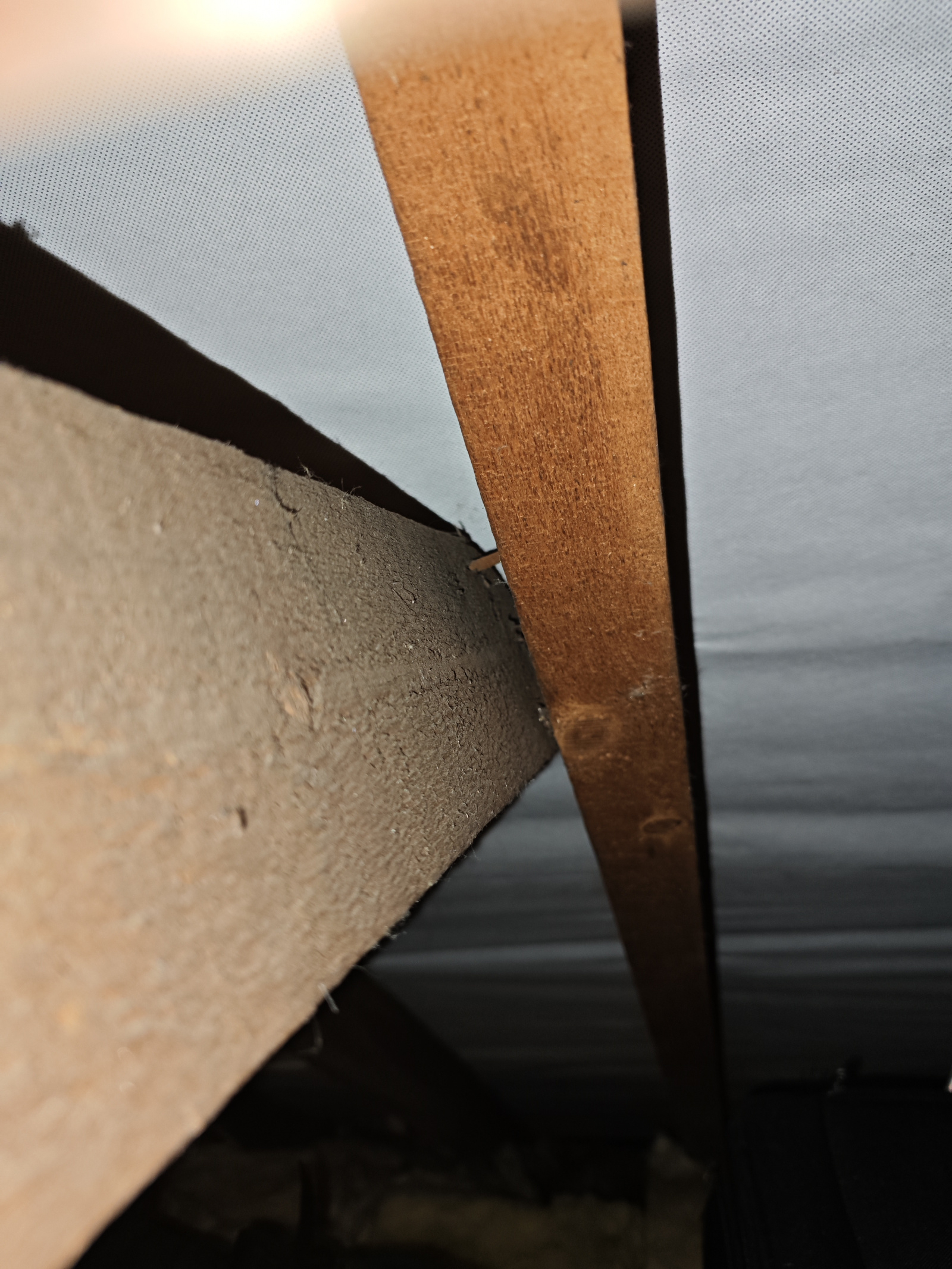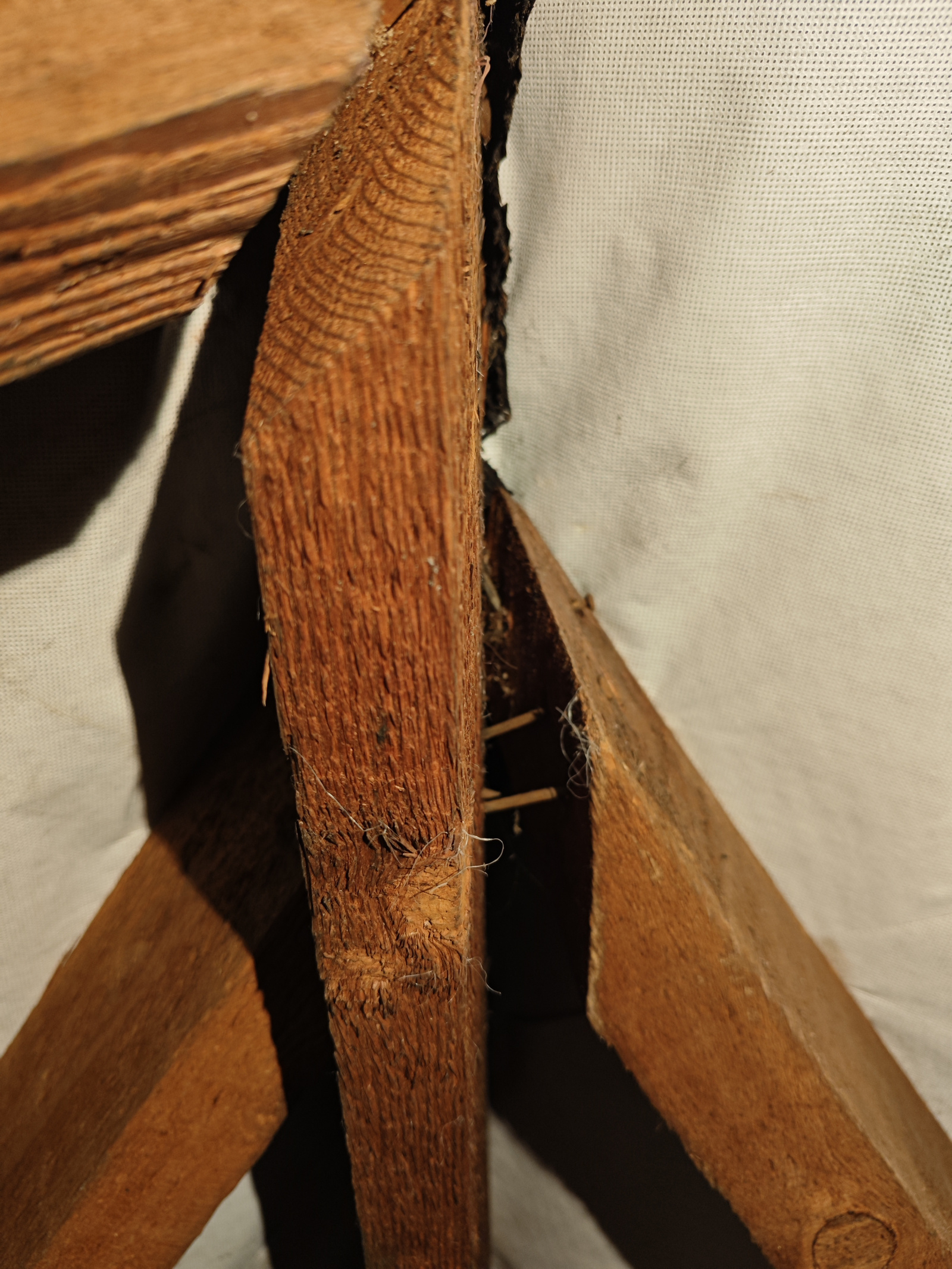We’d like to remind Forumites to please avoid political debate on the Forum.
This is to keep it a safe and useful space for MoneySaving discussions. Threads that are – or become – political in nature may be removed in line with the Forum’s rules. Thank you for your understanding.
The MSE Forum Team would like to wish you all a very Happy New Year. However, we know this time of year can be difficult for some. If you're struggling during the festive period, here's a list of organisations that might be able to help
📨 Have you signed up to the Forum's new Email Digest yet? Get a selection of trending threads sent straight to your inbox daily, weekly or monthly!
Has MSE helped you to save or reclaim money this year? Share your 2025 MoneySaving success stories!
New roof laid - a couple of beams shifted and seem a bit loose
augusto
Posts: 34 Forumite





Hi MSE community!
I'm in need of your help. Two weeks ago a company finished laying down a new roof at home. The propery was built ~1930 and the roof was a due to be replaced.
A couple of days ago, my wife noticed that 2 beams rotated (or twisted/shifted). I'm going to get in touch with the company that did the work but wanted to check here how bad is this. I'm not exactly knowledgeable about buildings and can easily be talked away if presented with a good story. We are also not sure when this happen, if during the work or afterwards, but it was definitely not like this before.
The beams rotated and the place where they join is about 1 inch away from where it should be. Here's a picture, with the separation at the top being ~1inch

Here's a picture of the other beam, again with a ~1inch gap

The questions I have are:
- Should I push the company that did this to address it? Would this mean setting scaffolding again? Or can is this something that can be fixed from inside the loft?
- Should I tell my insurance?
- And if the contractor refuses to address this, would the best way to deal with this be through the insurance?
We also noticed that the roof is a lot draftier than before and that there's quite a good amount of debris between the membrane and the tiles.
Thanks!
0
Comments
-
You need a Structural Engineer to look at it. Can happen when heavier tiles are used.3
-
It looks like a total bodge if it's in that state after just a couple of weeks. You will need to give them the opportunity to correct the work and then consider the options if/when they don't do a better job.
1 -
augusto said:Hi MSE community!I'm in need of your help. Two weeks ago a company finished laying down a new roof at home. The propery was built ~1930 and the roof was a due to be replaced.A couple of days ago, my wife noticed that 2 beams rotated (or twisted/shifted). I'm going to get in touch with the company that did the work but wanted to check here how bad is this. I'm not exactly knowledgeable about buildings and can easily be talked away if presented with a good story. We are also not sure when this happen, if during the work or afterwards, but it was definitely not like this before.The beams rotated and the place where they join is about 1 inch away from where it should be. Here's a picture, with the separation at the top being ~1inchHere's a picture of the other beam, again with a ~1inch gapThe questions I have are:- Should I push the company that did this to address it? Would this mean setting scaffolding again? Or can is this something that can be fixed from inside the loft?- Should I tell my insurance?- And if the contractor refuses to address this, would the best way to deal with this be through the insurance?We also noticed that the roof is a lot draftier than before and that there's quite a good amount of debris between the membrane and the tiles.Thanks!The wood looks old and the nails look rusty, so on first impressions I'd think the gaps have been there some time.Did your contract involve redoing the whole roof structure, or just stripping and membrane+batten+retiling?It might be possible to close some of the gaps up working from inside, but in other cases the tile batten may prevent much movement.I'd second stuart45's suggestion of getting a SE to take a look - either way there is something not right and having a SE report will help if you end up in a 'legal' situation with the company.2
-
Augusto, are these the original timbers? And, is your wife certain that they weren't like this to begin with?
What was the original slate/tile material, and what do you have now?
As for the draughty bit, that is usually good - it keeps your loft dry.
2 -
Thanks for the reply folks!
The contract was to replace the membrane, batons, tiles, etc, not the structure.Section62 said:I'd second stuart45's suggestion of getting a SE to take a look - either way there is something not right and having a SE report will help if you end up in a 'legal' situation with the company.
Thanks for the suggestion to get a SE. A friend of us who is a decorator put us in touch with one and he'll come around next week. Our friend came to see the roof and he didn't feel too concerned (a good thing!) and maybe a couple of clamps would be all that is needed to make it extra safe.ThisIsWeird said:Augusto, are these the original timbers? And, is your wife certain that they weren't like this to begin with?
What was the original slate/tile material, and what do you have now?
As for the draughty bit, that is usually good - it keeps your loft dry.I think these are the original timbers. An extension to the house was build ~30 years ago and the new timbers look very different (whiteish vs the old dark brown), which leads me to believe they are the originals. All the nails have a layer of rust that I think it's just from being there 90+ years.The tiles were replaced like for like. The original tiles were french (or at least a few roofers mentioned that) and were installed in all the houses in my neibourhood. The new ones are "Redland 49". From an untrained eye, they look similar in shape and weight.We are quite certain the beams moved, but don't have hard proof. We taken a lot of pictures of the property when we moved, I'll check that to see if I can find one.
1 -
From what you say - and from the pics - I'd agree that these are almost certainly the original timbers.
The Redlands tiles are concrete, so fairly heavy, and unlikely to be a suitable replacement for, say, much thinner and lighter slate, but you reckon the 'French' tiles you had were also 'concrete', at least very similar, presumably in both thickness and weight?
An SE should soon provide reassurance, and I'm going to hazard that all is fine. For example, that twisted timber which has pulled away from the rafter in your first pic has no visible sign that it was ever in close contact. I suspect the original roof was constructed in wet weather, and the timbers moved shortly afterwards as they dried out. It's not at all uncommon to see such large gaps having opened up over time in traditionally built roofs.
I hope that's the case.1
Confirm your email address to Create Threads and Reply

Categories
- All Categories
- 353K Banking & Borrowing
- 253.9K Reduce Debt & Boost Income
- 454.8K Spending & Discounts
- 246.1K Work, Benefits & Business
- 602.2K Mortgages, Homes & Bills
- 177.8K Life & Family
- 260K Travel & Transport
- 1.5M Hobbies & Leisure
- 16K Discuss & Feedback
- 37.7K Read-Only Boards


